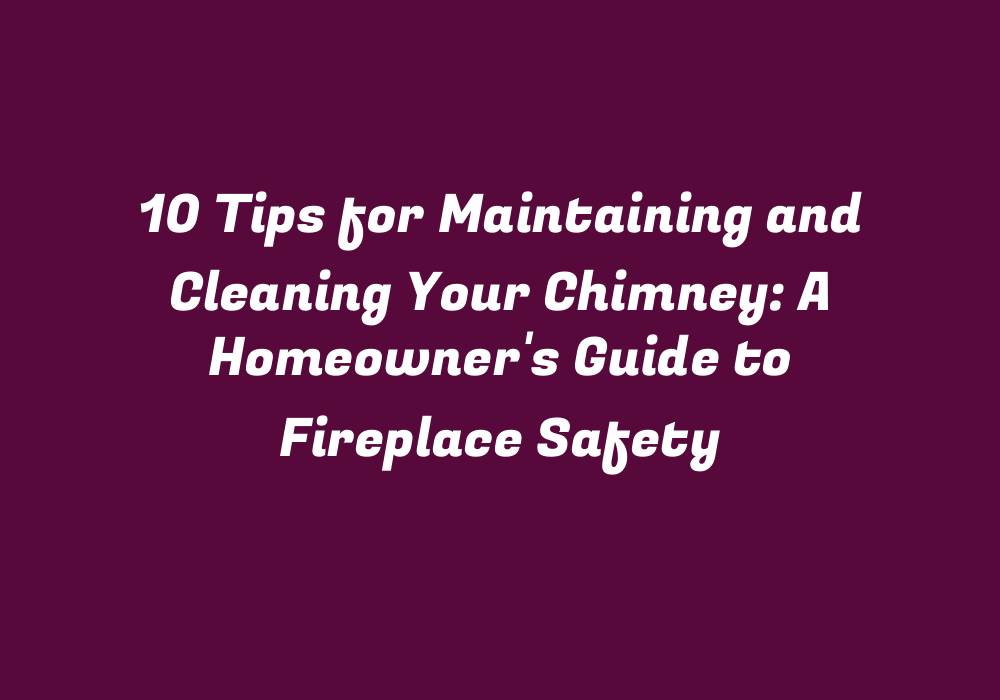Introduction
Maintaining and cleaning your chimney is of utmost importance for fireplace safety. Neglecting these tasks could lead to potential hazards such as house fires, carbon monoxide poisoning, or smoke damage. This comprehensive guide will outline 10 essential tips that homeowners can follow to ensure proper chimney care and safety for their fireplace systems.
Tip 1: Schedule Regular Inspections
The first step to maintaining your chimney is scheduling annual inspections by a professional chimney sweep. A qualified technician will assess the condition of your flue and chimney, looking for any signs of damage or blockage caused by creosote buildup, animals, or other factors that could compromise your fireplace’s efficiency and safety.
Tip 2: Clean Your Chimney Annually
It is crucial to have the chimney professionally cleaned annually, regardless of the frequency with which you use it. A buildup of soot, creosote, and other combustion byproducts can significantly reduce airflow and increase the risk of a dangerous chimney fire. Regular cleaning will maintain optimal functionality while ensuring your fireplace remains a safe source of warmth during those chilly winter evenings.
Tip 3: Install a Chimney Cap
Chimney caps serve two primary purposes: preventing rain and snow from entering the flue, and protecting against birds and small animals nesting in your chimney. Invest in a high-quality cap that is designed to fit your specific chimney size and design for optimal effectiveness in protecting your fireplace.
Tip 4: Monitor Chimney Efficiency
Ensure your fireplace burns efficiently by using only seasoned wood, which has been dried for at least six months to reduce moisture content. Proper wood selection will minimize the amount of creosote buildup in your chimney, leading to fewer inspections and cleanings. Also, remember to always let logs dry completely before burning them.
Tip 5: Monitor Your Chimney for Animal Intrusion
Keep a close eye on your chimney for signs of animal intrusion, as it can lead to nesting material blocking the flue and creating hazardous conditions for you and your family. Check the area around your fireplace regularly for any indications of animals, such as droppings or noise coming from within the chimney.
Tip 6: Install a Chimney Damper
A chimney damper is a device that helps regulate airflow through the flue and keeps out unwanted drafts when the fireplace isn’t in use. It is an essential addition to your home as it conserves heat, prevents cold air from entering the house, and contributes to energy efficiency.
Tip 7: Use a Chimney Liner
Investing in a chimney liner can significantly enhance your fireplace’s safety and efficiency by protecting the masonry walls of the chimney from heat damage while also reducing creosote buildup. Chimney liners are typically made from either clay tile, stainless steel, or cast-in-place flue liners to suit your specific needs.
Tip 8: Maintain Your Fireplace Surroundings
In addition to caring for the chimney itself, it is crucial to keep the firebox and surround areas clean and free from debris. Regularly sweep up soot, ash, and other deposits to ensure proper airflow and minimize the risk of any fire-related issues. Additionally, make sure your fireplace tools are appropriately maintained for optimal performance.
Tip 9: Utilize a Fireplace Screen
A fireplace screen serves as a protective barrier between the flames and your living space, preventing embers from flying out and potentially causing fires or damage to nearby items. Choose a high-quality screen that is appropriately sized for your fireplace opening and follow the manufacturer’s instructions for proper installation.
Tip 10: Practice Fire Safety Precautions
Finally, be vigilant about adhering to basic fire safety practices when using your fireplace. Always supervise any fires, maintain adequate clearance around the hearth, and keep a fire extinguisher nearby for emergencies. Also, ensure that the smoke detectors in your home are functioning correctly.
In conclusion, maintaining and cleaning your chimney is essential for ensuring fireplace safety within your home. By following these 10 tips and adopting a proactive approach to fireplace maintenance, you can minimize the risks associated with using wood-burning appliances and enjoy warm and cozy nights by the fire.
